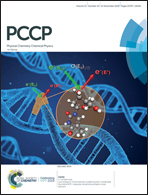Side chain effect on conjugated polymer/fullerene interfaces in organic solar cells: a DFT study†
Abstract
Considerable experimental research has been conducted on the influence of polymer alkyl side chains on the performance of bulk heterojunction organic solar cells. However, greater insight into the role of alkyl side chains in the polymer/fullerene interfacial regions is still needed. Using the dispersion-corrected density functional theory, we investigate the effect of alkyl side chains on the binding energies and electronic structures of various molecular pairings of fullerenes and monomers of organic copolymers (e.g. a pair of PC71BM and a monomer of copolymer PTB7 based on the thieno[3,4-b]thiophene/benzodithiophene repeat unit, PCBM and a copolymer PCDTBT based on 2,7-carbazole/dithienyl-2,1,3-benzothiazole and PC71BM and a copolymer PffBT4T-2OD based on difluorobenzothiadiazole/quaterthiophene). We find that the trends of the magnitudes of the binding energies vary with the lengths, types (branched or linear), and branching positions of alkyl side chains. Whenever possible, these results are compared with the efficiency trends of the corresponding organic solar cells. With the help of this comparison optimal side chain arrangements in bulk heterogeneous organic solar cells are identified. It is expected that these insights will aid in the production of more efficient organic photovoltaics.



 Please wait while we load your content...
Please wait while we load your content...